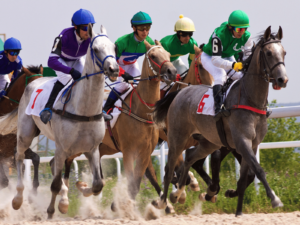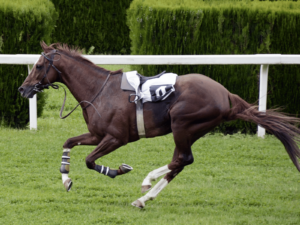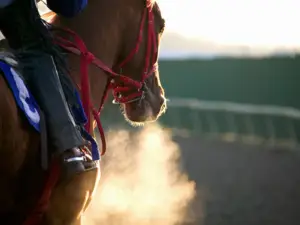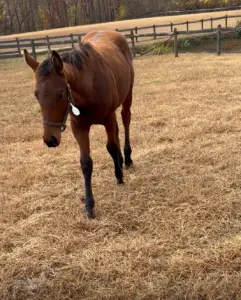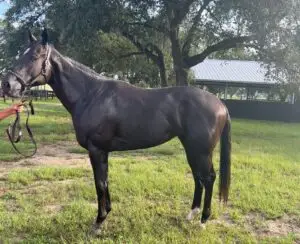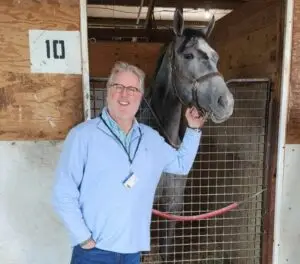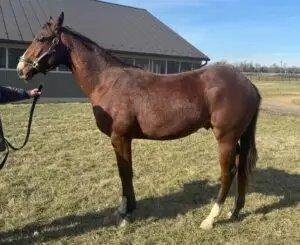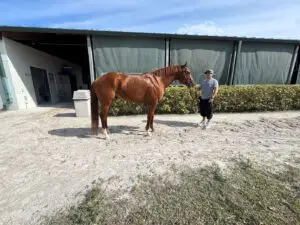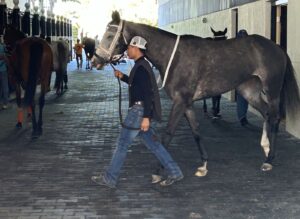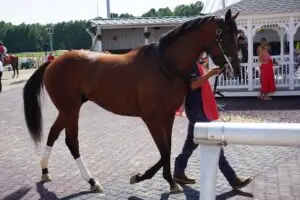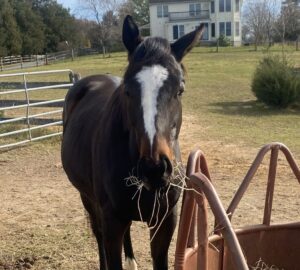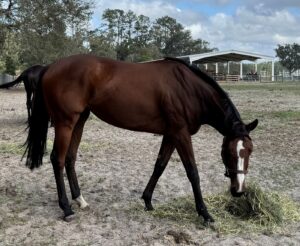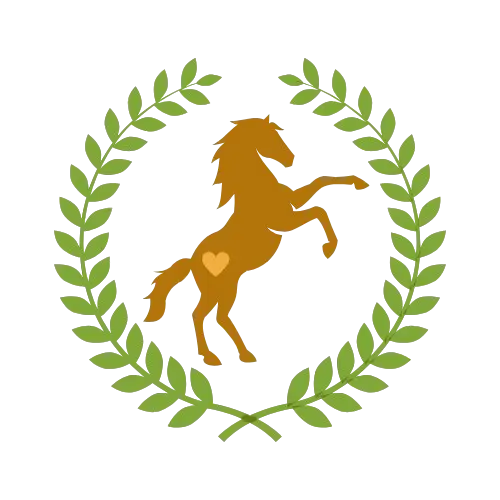For as long as there have been racehorses, breeders have chased the perfect bloodline. The right mix of speed, endurance, and temperament can mean the difference between an also-ran and a champion thundering down the homestretch.
But for decades, breeding was a high-stakes guessing game. Even with the best pedigrees, success was never guaranteed.
That’s changing.
Horse breeding technology is rewriting the playbook. With cutting-edge advancements, breeders now have tools that take the guesswork out of the equation. Every foal is born with data-backed potential—no longer just a roll of the dice.
We’re entering a new era. One where horse breeding technology is shaping the next generation of champions before they ever step onto the track.
The History of Horse Breeding Technology
Breeding racehorses has always been a game of high stakes. The right pairing could produce a champion.
But for most of history, breeders had to rely on instinct, experience, and a little bit of luck. No fancy tech. No genetic blueprints. Just good old-fashioned horse sense.
Not anymore
The way we breed racehorses today is almost unrecognizable from how it was done a century ago. Let’s take a ride through time and see how we got from handwritten pedigrees to AI-driven bloodline analysis.
The Early Days: Pedigrees and Intuition
Before science entered the picture, thoroughbred breeding was all about lineage and gut feeling. Breeders studied bloodlines like they were sacred texts, matching horses based on past performance and reputation.
But there was no way to know if a foal would inherit speed, stamina, or even the will to win. Some champions sired flops. Some average runners produced superstars. It was a roll of the genetic dice—sometimes you hit the jackpot, sometimes you didn’t.
The First Wave of Science: Blood Typing and Early Genetic Insights
In the mid-20th century, breeding took its first step into the world of science. Blood typing became a tool for verifying parentage, making it easier to track thoroughbred breeding accuracy.
Then came early genetic studies.
Researchers started identifying hereditary traits linked to performance, but the technology wasn’t refined enough to make precise predictions. It was progress, but breeders still had to rely heavily on experience and pedigree history.
The Data Revolution: Performance Tracking and Biomechanics
By the late 20th century, technology was moving faster than a sprinter out of the gate. Computerized databases allowed breeders to analyze massive amounts of racing and breeding data. Stallion rankings, dam success rates, and past performance trends became easier to study.
At the same time, biomechanics—analyzing a horse’s physical movement—became a key tool.
Slow-motion video, pressure sensors, and motion tracking gave breeders a better understanding of stride efficiency, bone structure, and muscle composition.
This was the first real shift away from breeding purely on paper. For the first time, breeders could see beyond bloodlines and assess how a horse moved—a critical factor in performance.
Modern Breakthroughs: AI, Genetic Testing, and the Future of Breeding
Fast forward to today, and horse breeding technology is light-years ahead of where it started. AI-driven genetic testing for horses can now pinpoint the exact genes linked to speed, endurance, and even injury resistance.
Advanced AI in horse breeding is analyzing pedigrees, biomechanics, and race records to predict success with a level of accuracy breeders from the past could only dream of.
Breeding a racehorse is no longer a shot in the dark. It’s data-driven. Precise. Scientific.
And we’re just getting started.
The Science Behind Horse Breeding Technology
The old way of breeding racehorses? It was part art, part educated guesswork. You matched a proven sire with a strong mare, crossed your fingers, and hoped for the best.
Now? We’re breeding with data.
Horse breeding technology has turned the process into a science—analyzing genetics, biomechanics, and performance metrics to produce faster, stronger, and more durable racehorses.
Breeders aren’t just studying bloodlines anymore; they’re diving deep into DNA, muscle composition, and even artificial intelligence to predict success before a foal is even born.
From Tradition to High-Tech: The Evolution of Thoroughbred Breeding
For generations, breeding was all about gut instinct. You looked at a pedigree, watched a horse move, and made an educated guess about its potential.
Some breeders had an eye for it—picking pairings that produced champions.
Others? Not so much.
Today, thoroughbred breeding is backed by hard data. AI-powered pedigree analysis can scan thousands of bloodlines in seconds, pinpointing ideal genetic matches.
Biomechanical tracking evaluates a horse’s conformation, stride efficiency, and muscle development before it ever takes its first step. Even predictive modeling is playing a role, forecasting a foal’s likely race performance based on generations of data.
Breeding is no longer just about tradition—it’s about precision.
Genetic Testing: Predicting Performance Traits
Ever wish you could peek into the future and know exactly how a young racehorse will perform? That’s exactly what genetic testing for horses allows breeders to do. By analyzing a foal’s DNA, breeders can identify performance-linked traits long before training even begins.
One of the most influential discoveries in equine genetics is the myostatin gene (MSTN)—a key factor in determining whether a horse will be a sprinter, a middle-distance runner, or a marathoner.
Horses with the “CC” variant excel in short bursts of speed, while “TT” horses thrive in endurance races. There’s even genetic testing to assess cardiovascular efficiency, muscle fiber composition, and susceptibility to common racing injuries.
The result? Smarter breeding decisions. Instead of pairing horses based on past race records alone, breeders can use genetic insights to maximize a foal’s potential before it ever sets hoof on a track.
AI in Horse Breeding: Smarter Decisions, Faster Champions
Imagine a breeding expert who never sleeps, never overlooks a detail, and can process decades of data in seconds. That’s what AI in horse breeding brings to the table. Machine learning algorithms are now analyzing race records, biometric data, and bloodlines with pinpoint accuracy—helping breeders predict which pairings will produce elite racehorses.
It’s not just about pedigree. AI can evaluate a horse’s gait, conformation, and even track preferences to refine breeding choices. Some programs go even further, using predictive analytics to assess injury risks before a horse ever steps into training.
And the results speak for themselves. AI-driven breeding decisions are leading to stronger, more resilient racehorses with greater career longevity.
Breeding is no longer a guessing game. It’s an equation—and AI is helping breeders solve it with precision.
Genetic Testing: Breeding for Champions
For decades, breeding racehorses was like rolling the dice. Even with the best sires and dams, you never really knew what you were going to get.
Now, thanks to genetic testing for horses, breeders can predict with remarkable accuracy which traits a foal will inherit—before it’s even born.
This isn’t just about bloodlines anymore. It’s about science.
What Genetic Testing Actually Examines
Not all racehorses are built the same. Some have explosive early speed, others have deep stamina reserves, and a few are simply more resistant to injury. Genetic testing for horses uncovers these hidden traits by analyzing DNA markers linked to performance, durability, and even temperament.
A few key areas genetic testing focuses on:
- Speed genes: The myostatin gene (MSTN) determines whether a horse is best suited for sprinting, middle-distance racing, or long-distance endurance
- Cardiovascular efficiency: Certain genetic markers indicate a larger heart, better oxygen utilization, and superior stamina
- Muscle composition: Genes that influence fast-twitch vs. slow-twitch muscle fibers can help predict a horse’s ideal racing distance
- Injury risk: DNA analysis can flag genetic predispositions to common racehorse injuries, such as tendon issues and stress fractures
By understanding these factors, breeders can make more informed decisions about which pairings will produce elite racehorses.
How Breeders Use Genetic Testing to Optimize Matings
Let’s say you have a mare with an outstanding race record, but she retired early due to tendon issues. In the past, you’d breed her to a top stallion and cross your fingers, hoping the foal wouldn’t inherit the same weaknesses.
Now?
You can run genetic tests to assess potential risks.
If the stallion carries a similar injury-prone gene, you might reconsider the match. On the other hand, if he has markers for exceptional durability, you’ve got a better shot at producing a foal with speed and longevity.
Breeders are no longer relying on intuition alone—they’re using genetic reports to stack the odds in their favor.
AI and Big Data: The Smartest Trainers in the Room
In horse racing, every fraction of a second counts. A single misstep can be the difference between victory and an also-ran finish.
But what if you could predict a horse’s potential before it ever took its first step?
That’s exactly what AI in horse breeding is making possible.
Artificial intelligence is revolutionizing how breeders analyze performance, identify ideal genetic pairings, and even forecast which horses will thrive under specific conditions.
It’s not just a tool—it’s the ultimate digital trainer, spotting advantages no human could ever see.
AI is Revolutionizing Racehorse Performance Analysis
Traditionally, performance analysis started when a young horse entered training. Trainers studied stride length, acceleration, and stamina over months—sometimes years—to determine where a horse would excel.
Now? AI is cutting that timeline down to before the foal is even born.
By analyzing thousands of race records, biometric scans, and pedigree data, AI can predict which foals will have the best shot at success. This isn’t just theoretical—AI is already being used to evaluate potential thoroughbred breeding pairings and maximize winning potential.
Algorithms That Predict Superstar Bloodlines
AI doesn’t just look at raw race times. It digs deeper, identifying breeding patterns that humans would miss.
- It evaluates stride efficiency, detecting mechanical flaws before a horse ever races
- It scans bloodlines for genetic compatibility, identifying the pairings most likely to produce elite foals
- It even factors in racecourse preferences, predicting which sires and dams will produce horses suited for turf, dirt, or synthetic tracks
Take Frankel, one of the greatest racehorses of all time. His dominance wasn’t just about his raw ability—it was a genetic goldmine.
AI-driven pedigree analysis now helps breeders replicate those kinds of legendary lineages with greater accuracy than ever before.
AI-Assisted Predictions for Stamina, Temperament, and Track Conditions
Ever wonder why some horses fight through the final furlong while others fade? Or why certain champions dominate at one track but struggle elsewhere?
AI has the answers.
By analyzing physiological data, AI can now predict stamina thresholds, determining if a foal will be built for sprinting, middle distances, or marathon races.
It can also detect temperamental traits, helping breeders select horses with strong competitive instincts—something that once relied purely on intuition.
Even track conditions are part of the equation. Some bloodlines excel on firm turf, while others need deep dirt tracks to show their best.
\AI identifies these surface preferences in advance, allowing trainers and owners to place their horses in races where they have the highest probability of winning.
The Future of AI in Horse Breeding
We’re only scratching the surface of what AI in horse breeding can do.
As machine learning models continue to evolve, we could soon see AI-driven race strategies, real-time injury predictions, and even virtual foal simulations—allowing breeders to “test” genetic pairings before making decisions.
The bottom line? AI is changing the way racehorses are bred, trained, and raced. The smartest trainers in the room aren’t just human anymore.
And the next generation of champions? They’re already being shaped—one algorithm at a time.
From Theory to Track: How Horse Breeding Technology Shapes Future Champions
Once upon a time, breeding racehorses was a gamble. Even the sharpest breeders relied on intuition, tradition, and the occasional stroke of luck.
The right bloodline didn’t always guarantee success, and predicting which foals would turn into champions?
That was anyone’s guess.
But now, horse breeding technology has changed the game.
With AI-driven analysis, advanced horse breeding techniques, and cutting-edge genetic testing, we’re no longer just hoping for greatness—we’re engineering it.
The question isn’t if a foal will be elite. It’s how elite it will be.
Breeding with Precision: The Science Behind Future Champions
For centuries, breeders trusted their gut. They studied pedigrees, evaluated conformation, and hoped that a sire’s past success would carry into his foals. But there were no guarantees.
Some blue-blooded horses flopped, while unexpected underdogs became legends.
Now, the industry is powered by racehorse performance analysis and genetic research. AI can analyze thousands of pedigrees, biometric data, and past performances to predict a foal’s potential with striking accuracy.
No more guesswork—just hard data guiding every decision.
Take speed and endurance, for example.
Genetic testing for horses now pinpoints markers linked to fast-twitch vs. slow-twitch muscle fibers, allowing breeders to match sires and dams based on the optimal racing distance for their foals.
AI can even assess stride mechanics and cardiovascular efficiency before a horse is born.
This shift isn’t just about producing winners—it’s about reducing risk.
By identifying injury-prone genetic markers, breeders can make informed choices that lead to healthier, more resilient racehorses with longer careers.
Data-Backed Breeding: A Faster, Stronger Generation
Advanced horse breeding techniques are making racehorse breeding more efficient than ever.
Take AI-driven analysis—it doesn’t just look at a horse’s raw speed; it evaluates how efficiently that speed is produced. Horses with biomechanically superior strides exert less energy and maintain top speeds longer.
And it’s not just about physical ability. AI is now being used to analyze temperament and competitive drive. Some horses have the raw talent but lack the mental edge to fight for a win in the final furlong.
By identifying behavioral markers in bloodlines, breeders can select for traits that lead to stronger, more determined racehorses.
Predicting Triple Crown Winners Before They’re Born?
Could we predict the next Secretariat before he even takes his first step?
It sounds futuristic, but we’re getting close.
With horse breeding technology, AI can now assess a foal’s genetic potential with remarkable precision.
The next step? Refining predictive models that consider not just raw ability but also adaptability to race conditions, mental resilience, and recovery rates.
Some scientists are even exploring how epigenetics—the study of how genes are expressed over time—might further refine breeding strategies.
Could we train a foal’s body to develop in a way that maximizes its genetic strengths? If so, we may be on the verge of producing the perfect racehorse before it ever sets hoof on a track.
One thing is certain: The future of thoroughbred racing isn’t just about speed anymore.
It’s about science, strategy, and staying one step ahead of the competition.
The Future of Horse Breeding Technology
We’ve come a long way from relying on instinct and bloodlines alone.
Horse breeding technology has already given us AI-driven pedigree analysis, genetic testing, and advanced horse breeding techniques that are reshaping the industry. But we’re only at the starting gate.
What’s next?
The future of thoroughbred breeding could bring even greater precision—maybe even the ability to design racehorses at the genetic level.
But as technology pushes forward, so do the ethical and regulatory questions surrounding it.
Can We Create the Perfect Racehorse?
It’s no longer just a question of selective breeding. Scientists are now exploring the potential of CRISPR and gene editing to refine equine genetics at the molecular level.
CRISPR is a gene-editing tool that works like molecular scissors, allowing scientists to cut and modify DNA with extreme precision.
The idea? Instead of breeding for the best traits, we could engineer them.
Imagine being able to:
- Remove genes linked to injury-prone bone structures
- Enhance muscle fiber composition for maximum sprinting efficiency
- Modify cardiovascular genes to improve endurance
On paper, it sounds like the ultimate breakthrough. In reality, we’re still far from implementing gene editing in competitive racing.
The technology exists, but the long-term effects of genetic manipulation in horses are still largely unknown. One misstep could result in unforeseen health issues—or worse, compromise the integrity of the sport altogether.
The Ethics and Regulations of Genetic Engineering
As with any major horse breeding innovation, the big question isn’t just can we do it—it’s should we?
Some regulatory bodies already have strict rules in place to prevent artificial genetic modifications in thoroughbred breeding.
If gene editing becomes an option, governing bodies will have to decide:
- Where do we draw the line between ethical breeding and genetic engineering?
- Would CRISPR-edited horses be allowed to compete against naturally bred ones?
- Could this technology create an unfair advantage for wealthier breeders?
Racing has always been about pushing limits, but when technology threatens to outpace tradition, the sport has to decide how far it’s willing to go.
What’s Next for Horse Breeding Technology?
For now, AI in horse breeding and genetic testing for horses will continue to refine the process, making breeding decisions smarter and more data-driven. In the coming years, we may see advancements such as:
- Personalized breeding programs using AI to match sires and dams based on thousands of variables
- Epigenetic conditioning, where a foal’s development is influenced before birth through environmental and genetic factors
- Real-time biometric monitoring that tracks a horse’s genetic expression as it trains and grows
One thing is certain: The future of horse breeding technology is going to keep evolving.
Whether it’s AI, gene editing, or something we haven’t even imagined yet, one thing remains the same—breeders will always chase the next great champion.
Final Stretch: The Impact of Horse Breeding Technology
Breeding racehorses has always been a high-stakes game. But with horse breeding technology, we’re no longer just relying on pedigree charts and gut instinct—we’re making decisions backed by science.
From genetic testing for horses to AI in horse breeding, technology is making breeding more precise, efficient, and profitable than ever before.
Breeders can now predict a foal’s potential before it takes its first steps. AI algorithms analyze thoroughbred breeding patterns, helping match the best bloodlines.
But for all this technology, the art of breeding still matters. A racehorse isn’t just the sum of its DNA—it’s heart, grit, and determination.
The best breeders know that technology is a tool, not a magic formula. The balance between science and intuition is what will continue to shape the future of the sport.
Whether you’re a breeder, an owner, or a bettor, staying ahead of these advancements is key. The future of thoroughbred breeding isn’t just about who has the best bloodlines—it’s about who’s using the best tools.
And in the race to breed the next great champion, the smartest players in the game will be the ones using horse breeding technology to its fullest potential.
Want to stay ahead of the curve? Now’s the time to get in the saddle.

